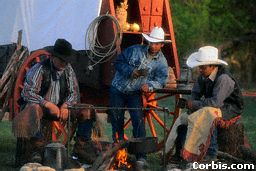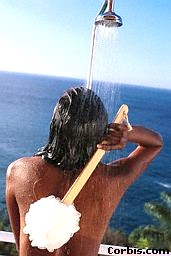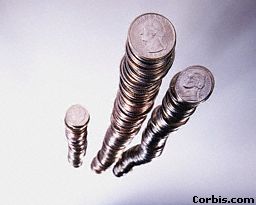|
|
Hank McIntyre
To "Nuclear Preparation" Section...

Look at "catastrophe" as a business opportunity instead of something to fear. This can be the time for us to see a great "turn-around" from the "haves" to the "have-nots": The Transfer of Wealth. In a time of social breakdown, those who can survive without outside help will be the kings of the underground economy. The wealthy people of today are wholly dependent on debt: mortgages, car loans, college loans, and the rest of it, all financing junk. The survivalist who efficiently purchases minimal basic hardware and food stores for a few bucks a month will be master of his domain when the well-ensconced, heavily-financed yuppies will find their paper-wealth suddenly, strangely powerless to protect them from reality.
Our currency is backed by NOTHING. In an emergency, money can be declared worthless. Then all citizens can be classified as "debtors" to the government. (The Federal Reserve is allowed to seize the collateral of the "Full faith and credit of the United States Government" if its exorbitant and unconstitutional interest payments cannot be met. That "full faith and credit" means YOU AND ME: we'd be at the service of government labor commissions as conscripted workers).Only the underground survivor can maintain his freedom should such events come upon us.

YOUR SURVIVAL COMPOUND
Let's say you can't afford a house just now. Can you afford a 10 - 20-year-old van? That is your new house. It's got room for all your survival "basics"; It has its own electric generator. And you can move to a better neighborhood at a moment's notice. Now the job is, how to ready it for being your survival center. BATTERIES. Depending on how much space you've got under the hood, install 1 or more additional 12V batteries (Preferably marine "Deep-Cycle" batteries: These are designed for repeated charging and discharging without wearing out). By using an INVERTER, you can run your household appliances from this 12 volt source.

SOLAR PANEL. You might not always be able to run the engine to charge your batteries - gas may be scarce. SOLAR PANELS keep the batteries charged even when the van is not running. UNISOLAR makes good weather-resistant panels with a plastic (not glass) surface that's more rugged and suitable for mobile use. 2 panels make a good system because during winter low-sun conditions, you can hook them in "series" (doubling the available voltage; This is critical when the winter sky causes the panels to generate as little as 6 volts [useless for recharging]. Connecting them in series will double it, thus producing a usable recharging voltage for at least a few hours). (www.windsun.com)
• (Link: Installing a Solar Power System in a Van - My Experience)

BASIC COOKING UTENSILS. The ordinary details of life take on a life-or-death importance in a survival scenario. If cooking equipment never filled your visions of a post-apocalyptic world of power struggles and intrigues, now it should. Cooking in the field requires rugged equipment: cast iron dutch ovens, campfire grills and the like. Space is at a premium so you'll want to keep it simple: 3 or 4 items to fire up the food and drinking water to keep yourself from getting dysentery. Check Lehmans (www.lehmans.com) or Cumberland General Store (www.cumberlandgeneral.com) catalogs for ideas. Then check local department stores: you can often get the same gear for half the price of the "disaster catalog."

KEEPING CLEAN. Washing when there's no municipal water supply can be achieved by using a solar shower bag, available at sporting goods stores & mail order houses like www.majorsurplusnsurvival.com. The bag, once filled with water, is placed in the sun until it reaches an agreeable temperature, or at least one that provides less of a shock. Of course you can always use water heated on a stove or grill. By rationing the water flow appropriately during use, turning it off while soaping down, two gallons of water can provide a decent shower. Another option is to punch a few small holes into the lids of several one-gallon milk jugs with an awl, a fine-tipped soldering iron or flame-heated pin, or nail, etc. Place these in the sun as well to heat up the water. (Black paint on the jugs will draw-in heat more rapidly during this process.)

WATER PURIFICATION. This subject is a product jungle, with advertisers threatening all kinds of deadly disease if you fail to buy their wonderful gadgets: Filters that cost hundreds and constantly need replacing. The best systems are WATER DISTILLERS, which collect the evaporated droplets of water, free of the contaminants which do not evaporate, but leave the contaminants which do evaporate (chemicals, fluoride, etc.) They cost between $600 - $1100. They also use huge amounts of electricity (~700 watts), are slow (12 hours per gallon), and require constant cleaning. To get the remaining contaminants out, you need a REVERSE OSMOSIS FILTER. These are as expensive as the distillers, and need constant replacement of filters, which are also expensive. Obviously neither of these fill the bill for practical survival.
A Cheap Solution: Stick 3 coffee filters over the base of a plastic planter/flower pot (with holes at the base); put a second pot over this to hold the filters in place. Turn topside-up, fill with water & let it trickle through into a pitcher. This will eliminate the greater part of physical contaminants, even microscopic ones, and it's cheap. Then boil the filtered water 7 to 15 minutes to kill off any remaining organisms, if necessary. For long term water storage, add 16 drops of bleach - "sodium hypochlorite" - type (such as "Clorox") - per gallon of water.
Water thus treated should be good for 1 year or more. (The bottle must remain sealed).
If after extended storage you need to drink this water and are unsure if it is still good, add 4 drops of chlorine bleach per gallon;
30 minutes later, check for a slight odor of chlorine: this means the water is safe. If you let this re-treated water sit in a sealed
container for an additional 24 hours, the chlorine will lose its offensive taste and scent and breakdown into salt and water.
HEAT. 4-Dog stove (www.fourdog.com) makes small, portable wood stoves that store easily. They'll provide some basic warmth using a few twigs and branches: suitable for a survival scenario where propane and kerosene are scarce.

NUCLEAR FALLOUT. After a nuclear attack, the thyroid is most vulnerable to radiation because it naturally absorbs all IODINE that passes through the body, and a nuclear detonation releases a s___load of RADIOACTIVE IODINE into the atmosphere. The way to protect the thyroid is to FLOOD it with "clean" iodine before the radioactive iodine gets to you. An adult needs 100 MG of iodine to flood the thyroid in this manner.
POTASSIUM , IODIDE (KI) and POTASSIUM IODATE (KI03), are the two types of iodine-delivering agents available to provide this protection. (NOTE: Elemental, or "free" (pure) iodine, or "Tincture of Iodine," is poisonous in the amounts we're discussing here, and cannot be used. The following forms of iodine formulae are designed to provide safe protection from radioactive iodine:)
With POTASSIUM IODIDE (KI), 130 MG is needed to yield 100 MG of iodine.
With POTASSIUM IODATE (KI03), 170 MG = 100 MG iodine.
Most brands' tablets are dosed so that 2 tablets equal 100 MG iodine.
Adults & adolescents age 13 & up: 100 MG IODINE = 130 MG POTASSIUM IODIDE (KI) OR 170 MG POTASSIUM IODATE (KI03).
Children: 50 MG IODINE = 65 MG IODIDE (KI), OR 85 MG IODATE (KI03).
Infants 1 month to 3 Years: 12.5 IODINE = 16 MG IODIDE (KI) OR 21 MG IODATE (KI03).
The World Health Organization rates KI and KI03 as equals in bio-availability and efficient uptake of stable iodine for thyroid-blocking, and that "there is no decisive difference in shelf life" between the two (5 years). The FDA makes no reference to Potassium Iodate (KI03) for some reason, but only Potassium Iodide (KI).
MAKING YOUR OWN. You can obtain Potassium Iodide (KI) USP, in powdered or granulated form inexpensively from some chemical supply houses. From this powdered stock one can make 2 types of solutions: "SATURATED," and "ANYTHING LESS-THAN SATURATED".
SATURATED SOLUTION: Fill a 2-fluid ounce bottle 60% of the way with powdered Potassium Iodide (KI). (This uses about 2 ounces [by weight] powdered iodide [KI]). Then add room-temperature water until bottle is 90% full. Place cap on bottle, shake vigorously for 2 minutes. SOME of the solid KI should remain undissolved at the bottom, which proves the solution is "saturated". this solution containing two-ounces Potassium Iodide (KI) equals 56.7 GRAMS. Using an ordinary household medicine dropper, one drop would contain 28 to 36 MG Potassium Iodide; Four drops yields 112 to 144 MG (130 MG being the recommended adult daily dose)
LESS-THAN-SATURATED SOLUTION. This can provide more accurate dosing, because larger amounts of water are used and the resulting solution can be measured with more common items such as measuring spoons or a graduated medicine dropper with amount-markings. For example, ONE LITER of water mixed with 26 GRAMS Potassium Iodide USP yields 1000 MILLILITERS (ml) Potassium Iodide solution. Each 5 ML of this solution contains 130 MG of Potassium Iodide (the recommended adult dose). 5 ML equals one measuring teaspoon.
Information: http://www.fda.gov/cder/guidance/4825fnl.htm (FDA report on iodide)
Some Product Sources:
Tablets:
www.tacda.org
- "The American Civil Defense Association" - IODIDE TABLET SOURCE -- Nuke/Disaster Preparation Site.
http://www.ki4u.com
"Medical Corps" KIO3
Granulated Potassium Iodide: (harder to find - these sites may not have it at any given time)
http://shop2.chemassociates.com/PAS-potassiumiodidesolid.html
http://www.medichest.com/potassiumiodidegranu.html .
 BOOKS. There's an almost unlimited number of "Survivalist" books, videos, computer software packages, etc, waiting to suck up your money. Too many of them have one idea related to survival and then just a lot of filler to make it into a "book". I try to find things that cover a lot and are concise.
BOOKS. There's an almost unlimited number of "Survivalist" books, videos, computer software packages, etc, waiting to suck up your money. Too many of them have one idea related to survival and then just a lot of filler to make it into a "book". I try to find things that cover a lot and are concise.
"US ARMY SURVIVAL MANUAL FM21-76"
(ISBN: 0967512395) can usually be
found for around 10 to 15 bucks in bookstores and covers
details you'd probably have to scour through 8 or 9
"survival" books to find.
An online version of the U.S Army Field Manual
"The Survivor Manual":
(ISBN: 0312284217) - St. Martins Griffin Press ($14.95) - Based on techniques taught to the U.S. Armed Forces and tested in actual survival situations over the decades. Fairly jam-packed with survival info and a comprehensive index to help locate it all. Useful illustrations rightly divide edible plants and animals from poisonous ones, and show how to make the traps, emergency gear and shelters described in the text.
"Preparing for
Catastrophe on a Budget" by Bruce LaRue
Covers a lot of good basic preparation from common household items. Deals with nuclear fallout, building a "safe" area in your home, food storage, living in close quarters and other demands of disaster survival. Not too big but it gets you off to a good start.
(This book was commonly available in 1999 for $15. I hadn't checked Amazon until recently, which lists it as a collector's item at $1195. [In case you're tempted, it's not that good.] If true, maybe I'll sell my copy and retire.)
"Preparing for
Catastrophe on a Budget" on Bookfinder
"Preparing for
Catastrophe on a Budget" on Amazon
© Hank McIntyre
|
|
|









